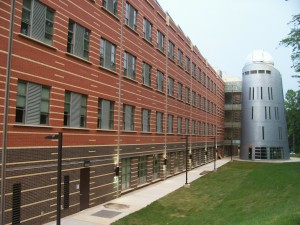
Our meetings on the second Sunday of the Month, The events are normally held evening at 7:00 pm in Research Hall Room 163 on the campus of George Mason University.
Our meetings web page, has directions and additional details.
We look forward to seeing you on Sunday evenings!

Our meetings on the second Sunday of the Month, The events are normally held evening at 7:00 pm in Research Hall Room 163 on the campus of George Mason University.
Our meetings web page, has directions and additional details.
We look forward to seeing you on Sunday evenings!
The Lyrids is an average shower, usually producing about 20 meteors per hour at its peak. It is produced by dust particles left behind by comet C/1861 G1 Thatcher, which was discovered in 1861. The shower runs annually from April 16-25. It peaks this year on the night of the night of the 22nd and morning of the 23rd. These meteors can sometimes produce bright dust trails that last for several seconds. The crescent moon should not be too much of a problem this year. Skies should still be dark enough for a good show. Best viewing will be from a dark location after midnight. Meteors will radiate from the constellation Lyra, but can appear anywhere in the sky.
http://www.seasky.org
The Eta Aquarids is an above average shower, capable of producing up to 60 meteors per hour at its peak. Most of the activity is seen in the Southern Hemisphere. In the Northern Hemisphere, the rate can reach about 30 meteors per hour. It is produced by dust particles left behind by comet Halley, which has known and observed since ancient times. The shower runs annually from April 19 to May 28. It peaks this year on the night of May 6 and the morning of the May 7. The waxing gibbous moon will block out many of the fainter meteors this year. But if you are patient, you should be able to catch quite a few of the brighter ones. Best viewing will be from a dark location after midnight. Meteors will radiate from the constellation Aquarius, but can appear anywhere in the sky.
http://seasky.org

We look forward to seeing you on Sunday evenings!

Our meetings on the second Sunday of the Month, The events are normally held evening at 7:00 pm in Research Hall Room 163 on the campus of George Mason University.
Our meetings web page, has directions and additional details.
We look forward to seeing you on Sunday evenings!

Our meetings on the second Sunday of the Month, The events are normally held evening at 7:00 pm in Research Hall Room 163 on the campus of George Mason University.
Our meetings web page, has directions and additional details.
We look forward to seeing you on Sunday evenings!
The Delta Aquarids is an average shower that can produce up to 20 meteors per hour at its peak. It is produced by debris left behind by comets Marsden and Kracht. The Delta Aquarids is an average shower that can produce up to 20 meteors per hour at its peak. It is produced by debris left behind by comets Marsden and Kracht. The shower runs annually from July 12 to August 23. It peaks this year on the night of July 28 and morning of July 29. The crescent moon will set by midnight, leaving dark skies for what should be a good early morning show. Best viewing will be from a dark location after midnight. Meteors will radiate from the constellation Aquarius, but can appear anywhere in the sky.
The Perseids is one of the best meteor showers to observe, producing up to 60 meteors per hour at its peak. It is produced by comet Swift-Tuttle, which was discovered in 1862. The Perseids are famous for producing a large number of bright meteors. The shower runs annually from July 17 to August 24. It peaks this year on the night of August 12 and the morning of August 13. The waning gibbous moon will block out many of the fainter meteors this year, but the Perseids are so bright and numerous that it should still be a good show. Best viewing will be from a dark location after midnight. Meteors will radiate from the constellation Perseus, but can appear anywhere in the sky.

Our meetings on the second Sunday of the Month, The events are normally held evening at 7:00 pm in Research Hall Room 163 on the campus of George Mason University.
Our meetings web page, has directions and additional details.
We look forward to seeing you on Sunday evenings!

